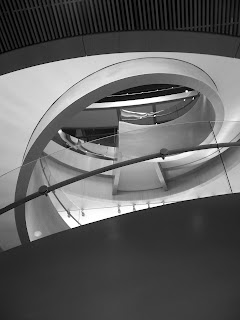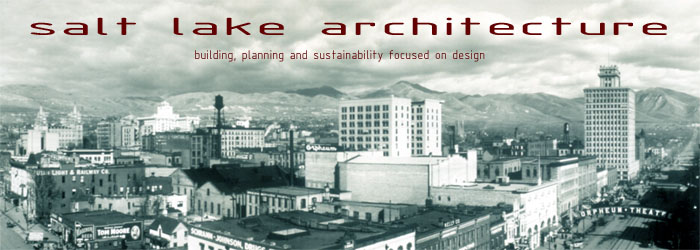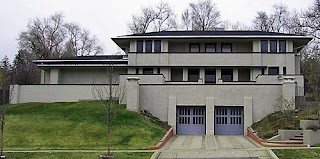
Constructed with the theme of “light and truth,” the modern glass facade of the building’s main entrance contrasts with a cloistered inner courtyard featuring a fountain. The glass-enclosed gallery, a beautiful, light-drenched space, is designed to house a series of exhibits that will expand on the educational experiences offered in the building. (BYU Today, Fall 2005)
Joseph F Smith Building
Brigham Young University Campus-Provo, UT
Architect: FFKR
Size: 280,000 SF, 5 story
Construction Began: 3 Jun 2002
Dedication: 20 Sep 2005

Entry to courtyard

Inner courtyard perimeter
Paid for through private donations, the building will feature 27 classrooms, 401 faculty and administrative offices, a large auditorium, a theater, and a three-level, 265-stall underground parking lot. The new building will contain more than double the square footage of its predecessor on a smaller footprint.
The building is intended to function as a work of art that sends a visual message, says Van C. Gessel, dean of the College of Humanities. "The architectural concept emphasizes light as the source of any kind of knowledge and learning. Education at BYU is very much about the light that comes from the Spirit."
To bring natural light into as many offices and public areas as possible, the architectural firm of FFKR designed the building around a central landscaped courtyard. A massive two-story glass gallery will grace the main entrance on the east, and generous use of glass throughout will permit light to enter much of the facility, including some of the basement. (BYU Today, Summer 2002)

Inner courtyard landscaping and benches

Sun screen shading device on west facade in courtyard

Close-up of sun screen shading device
I was pleasantly surprised by this building and my overall critique is a positive one. All buildings send a visual message, whether intended or not, so what type of message you are sending becomes the goal to think about and explore. I was glad to see the theme of ‘light and truth’ as a design guide for this project.
Unfortunately the theme appears to largely have been a missed opportunity with this building. As an unattached bystander, very little about the building says to me light or truth more than other buildings. I would have liked to see the theme pushed further. There is an inconsistent handling of light control. When speaking about light, the treatment of the south facade should be completely different from that of the north facade, and this building treats them the same.
Also, it’s not just about flooding the building with as much natural light as possible as was mentioned above. What do you do with that light? How do you harness, channel, and distribute that light to the occupants? What do the ‘light features’ teach the occupants of the building about knowledge and education? How could the building itself become an actual symbol of light and truth? Exploring this in built form could inform a spiritual yearning for harnessing, channeling, and utilizing a spiritual light in education.

Gallery spiral stair

Gallery spiral stair
What was done beautifully is applying the program of housing the College of Family, Home, and Social sciences into the design. The LDS Church views the family as sacred and is very protective of the institution of marriage and the family. This building supports that belief. The mostly non-descript exterior of the building acts as a protective wrapper providing an inner courtyard where the real beauty of the building lies. Here, the best design and materials have been used. Here, the beautiful landscaping creates a relaxed, welcome, and soothing environment. The building surrounding on all sides creates a sense of safety and intimacy. This protected enclave for study, discussion, or relaxing is symbolic of the role the College hopes to play relating to the family.
The wrapping and enclosing concept is further reinforced in the beautiful and striking circular gallery stair prominently located as one of the main features of the building. Similar to the courtyard, this feature of the building really draws you in with a desire to experience the space. This links nicely with the College also, where teachings about the family will draw you in and be provided with a protective enclosure, allowing interdisciplinary teachings about the family to come together into one place.
The final example of wrapping and protective enclosure is at a smaller, more intimate scale of a series of six gathering spaces in front of the building, using landscaped circular seating in concrete and vegetation.

Gallery spiral stair

Gallery spiral stair

Gallery spiral stair
Where I get lost in the metaphor at the gallery stair is being drawn from the lower level to the light above, when most of the classrooms and teaching occur at the lower level, not up where the light is. The light is taking you away from where you are learning.
Finally, there are some beautiful details that were fortunately not removed for budgetary considerations, such as the exterior curtain wall extensions and the wood cubicles over some of the interior doors.


One of six gathering spaces in front of the building that reinforces the courtyard and spiral stair concept of wrapping and protective enclosure.
*All images taken by author on 13 Jun 2009
View salt lake architecture in a larger map













